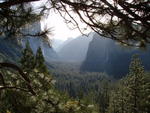Despite near-record dry conditions, 2014 was an active year for rockfalls in Yosemite. In all, there were 77 documented rockfalls, which is considerably more than the recent (2006-2013) average of about 45 rockfalls per year. Most of the rockfalls in 2014 were relatively small, with a total volume of about 6,500 cubic meters (about 19,350 tons).
The largest rockfall of 2014 occurred at 1:30 pm on March 31 from the north wall of Hetch Hetchy valley near Wapama Falls. This rockfall had a volume of roughly 5,000 cubic meters (about 14,880 tons). Rock debris buried a 120 meter-long section of the Rancheria Trail along the north shore of the reservoir, necessitating a multi-week closure while the trail was rebuilt. The second largest rockfall of 2014 occurred at about 4:30 am on the morning of June 11, when a 450 cubic meter (1340 tons) block fell from the southeast face of El Capitan near Horsetail Falls. The block fragmented on impact, creating a large dust cloud that lingered in western Yosemite Valley for more than an hour.
The most consequential rockfall of 2014 occurred at 8:15 pm on June 29, when a rock slab of about 215 cubic meters (about 640 tons) fell from the east wall of Indian Canyon. Although nobody was in this remote area at the time, a segment of the communications cable running up Indian Canyon was destroyed, cutting off all phone communications to White Wolf and Tuolumne Meadows. The cable was replaced by a microwave transmitter.
Perhaps the most important rockfall of 2014 was also one of the smallest. At 3:22 am on the morning of February 11, a rockfall of approximately 15 cubic meters (about 45 tons) occurred in the vicinity of Staircase Falls above Curry Village. Previous rockfalls in 2003 and 2007 damaged cabins, caused injuries, and prompted evacuations. In contrast, the February 11, 2014 rockfall was hardly noticed because cabins there were removed in late 2013 following a comprehensive assessment of rockfall hazard and risk, http://pubs.usgs.gov/sir/2014/5129/. One boulder landed within the footprint of a former cabin. This event, described in a short publication, http://onlinelibrary.wiley.com/doi/10.1002/2014EO290002/pdf, demonstrated the merit of removing buildings from hazardous areas.
Other areas in Yosemite experiencing rockfalls in 2014 include Yosemite Falls, Royal Arches, LeConte Gully, and the Merced River Gorge; these latter rockfalls were related to the Dog Rock Fire in early October.
It is very likely that there were additional rockfalls in 2014, but these events either were not witnessed or went unreported. However, the significant increase in the number of small rockfalls in 2014 suggests more thorough reporting of rockfalls (and likely not a real increase in small rockfalls). If you witness a rockfall of any size, encounter fresh rock debris, or hear cracking or popping sounds emanating from the cliffs, please contact park geologist Greg Stock at 209/379-1420 or by email at greg_stock@nps.gov, or contact Park Dispatch by dialing 911 within the park. Documented rockfalls are added to the park database, http://pubs.usgs.gov/ds/746/, enabling evaluation of rockfall activity to improve public safety.
Re: Yosemite Rockfall Year in Review: 2014
All posts are those of the individual authors and the owner
of this site does not endorse them. Content should be considered opinion
and not fact until verified independently.
Sorry, only registered users may post in this forum.


